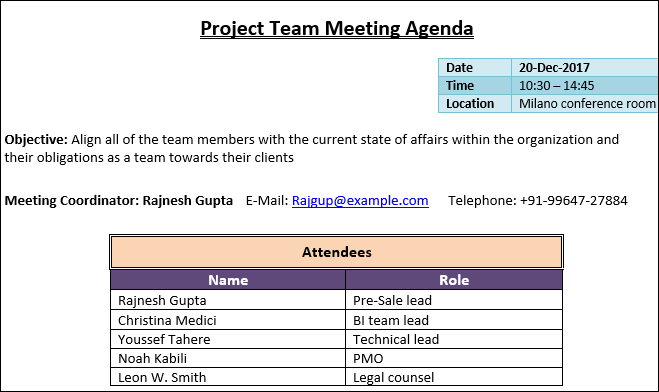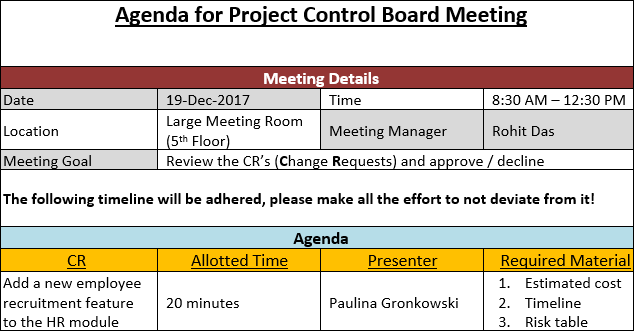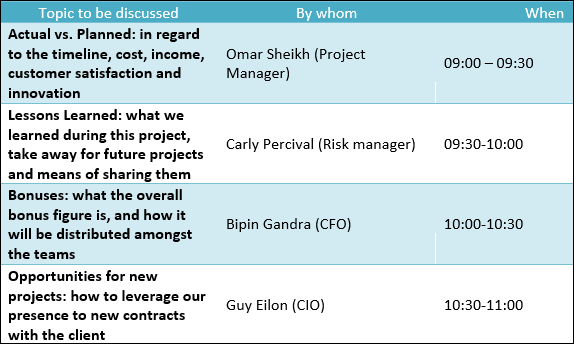Team Meeting Agenda Template
Definition of Agenda
An agenda lists all of the activities / topics which are planned to be discussed during a team meeting, along with their specific start and end time. Team Meetings Agenda is customarily sent a few days before the meeting takes place, and is also presented at the opening of the meeting. It also has the list of expected attendees and the goal of the meeting. The details of the meeting are usually also listed in the agenda: date, duration, location, meeting chair, etc.

The agenda may contain the presentations, documents or any other material which will be shared during the meeting itself.
Project Team Meeting Agenda Template
The format of the team meeting agenda contains the essential information, which explains to the attendees where and when it will take place. This is done in the table at the top of the page, and right below that is the goal (objective) of the meeting.
In the row right below that is the name and contact information of the organizer (chair) of the meeting, and a table with the names and rolls of the other attendees.
The format of the topics is a simple row with left tabs that control the location of the topic itself. The beginning of the row contains the hours which will be dedicated to the topic, and the name of the presenter in parenthesis.
The first and last topics are dedicated to the chair of the meeting, and are aimed at reviewing the MoM of the last meeting and updating the tasks which appear in it. The last topic is aimed at reviewing the tasks which were agreed upon in the meeting, allocating them to certain team members and agreeing on their timeline for completion. The other topics include all of the new features and news which affects the team since the last meeting occurred. Usually these are presented by the team leads, or their proxy.
Project Status Meeting Agenda

This agenda can be used for planning a periodic meeting with the projects team-members, which is aimed at aligning all of them regarding the status of the project. The table at the top includes the basic information of the meeting: When (date and time), location, organizer (chair) and attendees are listed below the table in a simple row. The table also contains the goal of the meeting.
The agenda also lists all of the topics which will be discussed, their hours and who will explain them to the team. This is presented in a simple table format, and the overall duration allocated to each of the presenters appears at the end of each topic in a gray row.
The first and last topics are under the responsibility of the meeting coordinator (chair), and include the review of the MoM of the last team meeting and the timeline for the tasks which will be agreed upon in this one. Each TL presents the status of their team tasks, timeline and / or main risks.
Kick Off Meeting Agenda Template

The official start of a project is its kick-off meeting, and the agenda for this type of meeting lists the topics which are planned to be discussed. This agenda should be sent to all of the team members of the project, its key stakeholders and the management team of the organization well in advance of the actual kick-off. This will allow them to review the SOW and contract which are attached to the agenda, and prepare comments and questions.
The top part of the agenda contains its basic information: objective, date, time, location, dial-in code and runners of the meeting. Below the basic information are the attachments, which will be reviewed during the meeting.
The topics are listed below the attachments, and contain the timeline of each topic, as well as who will be presenting it and their respective roles in the project. Below the topics is the contact information of the meeting runners, in case any of the attendees wish to raise issues, questions or queries before the meeting occurs. The topics include high-level information regarding the timeline, deliverables, R&R of all the teams and tasks. There is also time allotted for Q&A and addressing the team by the CEO (for motivational purposes).
Board Meeting Agenda Template - Project Control

A deviation from the original plan, features or customization or any type of change in a project requires approval from its management team. They want to review the cost – benefit analysis of the change, and then decide whether it has been approved or declined. This offers control over the expenses of the project and also documentation of the changes from the original plan.
The agenda for the control board meeting contains the basic information in a table format at the top of the page: the location, time, date, who will manage (and decide if the changes are approved or declined) the meeting, and its goal. Since there are normally quite a few change requests in any given project, there is also a request to adhere to the allotted timeline of the meeting.
In the table below the basic information is the agenda for the meeting. This includes four columns –
- The name of the CR (Change Request)
- The duration allotted to the presenter.
- The name of the presenter.
- What the presenter is required to present during the meeting.
Since each presenter is asked to provide different materials during the meeting, it is pertinent to send the agenda well in advance of the meeting.
Project Closure Meeting Agenda

After a project is delivered to the client, and just before its entire team-members move on to other projects, it is recommended to conduct a closure meeting which is the official end of the project.
The agenda for this type of meeting contains the basic information in the top row: the goal of the meeting, where and when it is planned to take place and who will run the meeting.
The actual agenda appears in a table format –
- The topics to be discussed
- Who will present them (name and role)
- Specific time for presenting the topic
The topics include the basic plan vs. actual for the timeline, PNL (Profits and Loss) and any other relevant information for the specific project. The goal of this exercise is to help the team plan better for their next project. These conclusions will be captured in the next topic of the meeting: the lessons learned. The meeting may also include any bonuses which will be divulged to the team members for a job well done. The last topic is usually the opportunities which are available as a result of the project.
The bottom table includes the list of attendees: name, role and E-mail address. There is also a row stating that all of the presentations which are planned to be shared during the meeting will be shared prior to the meeting.
Project Review Meeting Agenda
Every once in a while the management of the organization want to understand the status of one of its projects. This is usually achieved by scheduling a review meeting with the project's managers and team leads.
The agenda for this type of meeting normally contains the name of the project, the location and time of the meeting and its goal. The attendees also appear at the top of the page, as well as the materials which are planned to be reviewed and will explain the status of the project to the management team of the organization.
The agenda is then listed in a row format, with the topic, timeline and role of the presenter listed in each bullet point. The topics are according to the teams which are a part of the project, and each TL is asked to present their teams status and main risks. The first and last topics are under the responsibility of the PM. The list of attendees will be sent before the meeting.




